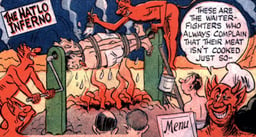Hell
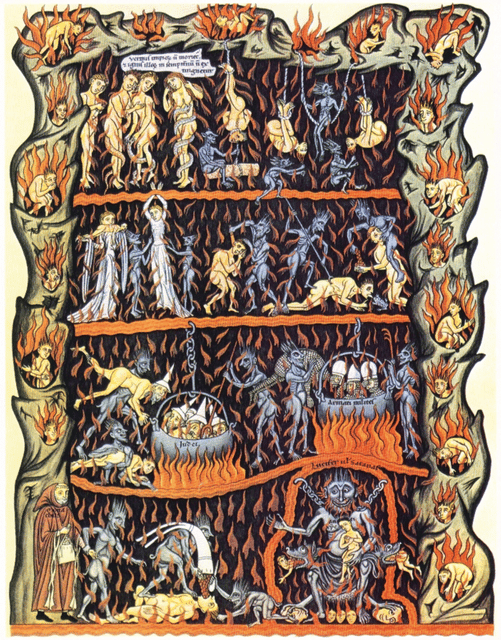
Hell
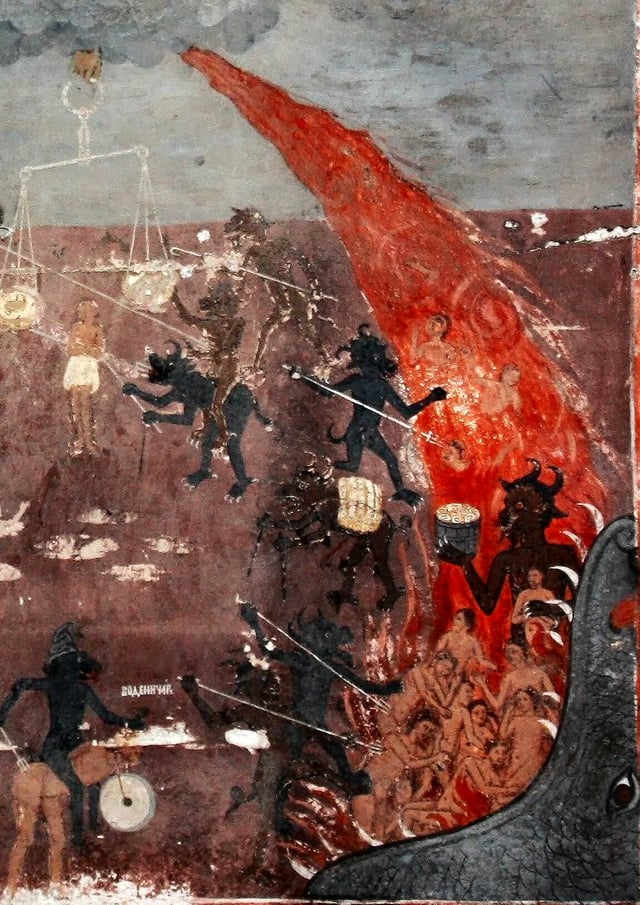
Hell – detail from a fresco in the medieval church of St Nicholas in Raduil, Bulgaria
In religion and folklore, Hell is an afterlife location in which evil souls are subjected to punitive suffering, often torture as eternal punishment after death. Religions with a linear divine history often depict hells as eternal destinations, the biggest examples of which are Christianity and Islam, whereas religions with reincarnation usually depict a hell as an intermediary period between incarnations, as is the case in the dharmic religions. Religions typically locate hell in another dimension or under Earth's surface. Other afterlife destinations include Heaven, Paradise, Purgatory, Limbo, and the underworld.
Other religions, which do not conceive of the afterlife as a place of punishment or reward, merely describe an abode of the dead, the grave, a neutral place that is located under the surface of Earth (for example, see Kur, Hades, and Sheol). Such places are sometimes equated with the English word 'hell', though a more correct translation would be 'underworld' or 'world of the dead'. The ancient Mesopotamian, Greek, Roman, and Finnic religions include entrances to the underworld from the land of the living.
Etymology
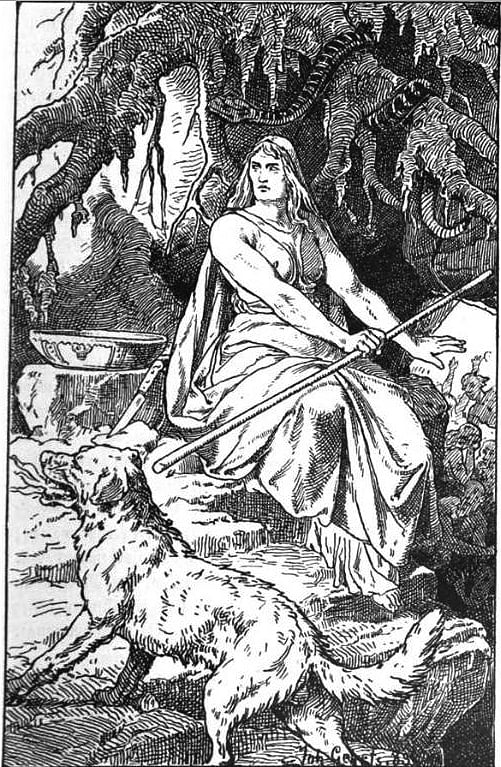
Hel (1889) by Johannes Gehrts, depicts the Old Norse Hel, a goddess-like figure, in the location of the same name, which she oversees
The modern English word hell is derived from Old English hel, helle (first attested around 725 AD to refer to a nether world of the dead) reaching into the Anglo-Saxon pagan period.[1] The word has cognates in all branches of the Germanic languages, including Old Norse hel (which refers to both a location and goddess-like being in Norse mythology), Old Frisian helle, Old Saxon hellia, Old High German hella, and Gothic halja. All forms ultimately derive from the reconstructed Proto-Germanic feminine noun *xaljō or haljō ('concealed place, the underworld'). In turn, the Proto-Germanic form derives from the o-grade form of the Proto-Indo-European root **kel-, *kol-: 'to cover, conceal, save'.[2] Indo-European cognates including Latin cēlāre ("to hide", related to the English word cellar) and early Irish ceilid ("hides"). Upon the Christianization of the Germanic peoples, extension of Proto-Germanic *xaljō were reinterpreted to denote the underworld in Christian mythology,[1][3] for which see Gehenna.
Related early Germanic terms and concepts include Proto-Germanic **xalja-rūnō(n)*, a feminine compound noun, and *xalja-wītjan, a neutral compound noun. This form is reconstructed from the Latinized Gothic plural noun *haliurunnae (attested by Jordanes; according to philologist Vladimir Orel, meaning 'witches'), Old English helle-rúne ('sorceress, necromancer', according to Orel), and Old High German helli-rūna 'magic'. The compound is composed of two elements: *xaljō (*haljō) and *rūnō, the Proto-Germanic precursor to Modern English rune.[4] The second element in the Gothic haliurunnae may however instead be an agent noun from the verb rinnan ("to run, go"), which would make its literal meaning "one who travels to the netherworld".[5][6]
Proto-Germanic *xalja-wītjan (or *halja-wītjan) is reconstructed from Old Norse hel-víti 'hell', Old English helle-wíte 'hell-torment, hell', Old Saxon helli-wīti 'hell', and the Middle High German feminine noun helle-wīze. The compound is a compound of *xaljō (discussed above) and *wītjan (reconstructed from forms such as Old English witt 'right mind, wits', Old Saxon gewit 'understanding', and Gothic un-witi 'foolishness, understanding').[7]
Religion, mythology, and folklore
Hell appears in several mythologies and religions. It is commonly inhabited by demons and the souls of dead people. A fable about Hell which recurs in folklore across several cultures is the allegory of the long spoons. Hell is often depicted in art and literature, perhaps most famously in Dante's Divine Comedy.
Punishment
Punishment in Hell typically corresponds to sins committed during life. Sometimes these distinctions are specific, with damned souls suffering for each sin committed (see for example Plato's myth of Er or Dante's The Divine Comedy), but sometimes they are general, with condemned sinners relegated to one or more chamber of Hell or to a level of suffering.
In many religious cultures, including Christianity and Islam, Hell is often depicted as fiery, painful, and harsh, inflicting suffering on the guilty. Despite these common depictions of Hell as a place of fire, some other traditions portray Hell as cold. Buddhist - and particularly Tibetan Buddhist - descriptions of Hell feature an equal number of hot and cold Hells. Among Christian descriptions Dante's Inferno portrays the innermost (9th) circle of Hell as a frozen lake of blood and guilt.[8] But cold also played a part in earlier Christian depictions of Hell, beginning with the Apocalypse of Paul, originally from the early third century;[9] the "Vision of Dryhthelm" by the Venerable Bede from the seventh century;[10] "St Patrick's Purgatory", "The Vision of Tundale" or "Visio Tnugdali", and the "Vision of the Monk of Eynsham", all from the twelfth century;[11] and the "Vision of Thurkill" from the early thirteenth century.[12]
Polytheism
Ancient Mesopotamia
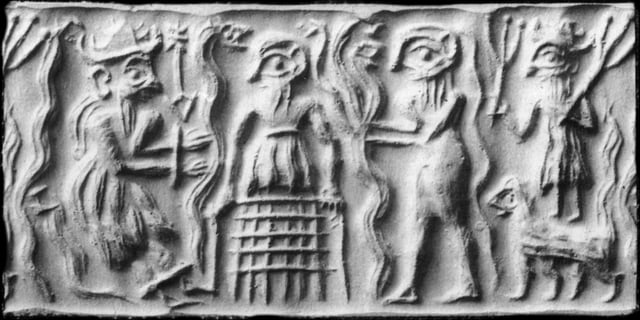
Ancient Sumerian cylinder seal impression showing the god Dumuzid being tortured in the Underworld by galla demons
The Sumerian afterlife was a dark, dreary cavern located deep below the ground,[13] where inhabitants were believed to continue "a shadowy version of life on earth".[13] This bleak domain was known as Kur,[14] [] and was believed to be ruled by the goddess Ereshkigal.[13][15] [] All souls went to the same afterlife,[13] and a person's actions during life had no effect on how the person would be treated in the world to come.[13]
The souls in Kur were believed to eat nothing but dry dust[14] [] and family members of the deceased would ritually pour libations into the dead person's grave through a clay pipe, thereby allowing the dead to drink.[14] [] Nonetheless, funerary evidence indicates that some people believed that the goddess Inanna, Ereshkigal's younger sister, had the power to award her devotees with special favors in the afterlife.[13][16] During the Third Dynasty of Ur, it was believed that a person's treatment in the afterlife depended on how he or she was buried;[14] [] those that had been given sumptuous burials would be treated well,[14] [] but those who had been given poor burials would fare poorly.[14] []
The entrance to Kur was believed to be located in the Zagros mountains in the far east.[14] [] It had seven gates, through which a soul needed to pass.[13] The god Neti was the gatekeeper.[15] [] [14] [] Ereshkigal's sukkal, or messenger, was the god Namtar.[14] [] [15] [] Galla were a class of demons that were believed to reside in the underworld;[14] [] their primary purpose appears to have been to drag unfortunate mortals back to Kur.[14] [] They are frequently referenced in magical texts,[14] [] and some texts describe them as being seven in number.[14] [] Several extant poems describe the galla dragging the god Dumuzid into the underworld.[14] [] The later Mesopotamians knew this underworld by its East Semitic name: Irkalla. During the Akkadian Period, Ereshkigal's role as the ruler of the underworld was assigned to Nergal, the god of death.[13][15] [] The Akkadians attempted to harmonize this dual rulership of the underworld by making Nergal Ereshkigal's husband.[13]
Ancient Egypt
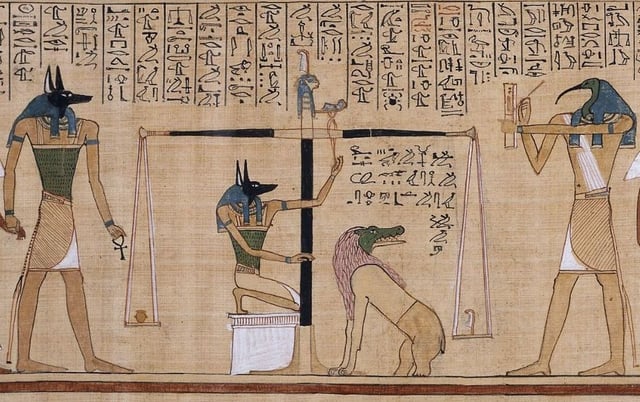
In this ~1275 BC Book of the Dead scene the dead scribe Hunefer's heart is weighed on the scale of Maat against the feather of truth, by the canine-headed Anubis. The ibis-headed Thoth, scribe of the gods, records the result. If his heart is lighter than the feather, Hunefer is allowed to pass into the afterlife. If not, he is eaten by the crocodile-headed Ammit.[17]
With the rise of the cult of Osiris during the Middle Kingdom the "democratization of religion" offered to even his humblest followers the prospect of eternal life, with moral fitness becoming the dominant factor in determining a person's suitability. At death a person faced judgment by a tribunal of forty-two divine judges. If they had led a life in conformance with the precepts of the goddess Maat, who represented truth and right living, the person was welcomed into the heavenly reed fields. If found guilty the person was thrown to Ammit, the "devourer of the dead" and would be condemned to the lake of fire.[18] The person taken by the devourer is subject first to terrifying punishment and then annihilated. These depictions of punishment may have influenced medieval perceptions of the inferno in hell via early Christian and Coptic texts.[19] Purification for those considered justified appears in the descriptions of "Flame Island", where humans experience the triumph over evil and rebirth. For the damned complete destruction into a state of non-being awaits but there is no suggestion of eternal torture; the weighing of the heart in Egyptian mythology can lead to annihilation.[20][21] The Tale of Khaemwese describes the torment of a rich man, who lacked charity, when he dies and compares it to the blessed state of a poor man who has also died.[22] Divine pardon at judgement always remained a central concern for the Ancient Egyptians.[23]
Modern understanding of Egyptian notions of hell relies on six ancient texts:[24]
The Book of Two Ways (Book of the Ways of Rosetau)
The Book of Amduat (Book of the Hidden Room, Book of That Which Is in the Underworld)
The Book of Gates
The Book of the Dead (Book of Going Forth by Day)
The Book of the Earth
The Book of Caverns
Greek
In classic Greek mythology, below Heaven, Earth, and Pontus is Tartarus, or Tartaros (Greek Τάρταρος, deep place). It is either a deep, gloomy place, a pit or abyss used as a dungeon of torment and suffering that resides within Hades (the entire underworld) with Tartarus being the hellish component. In the Gorgias, Plato (c. 400 BC) wrote that souls were judged after death and those who received punishment were sent to Tartarus. As a place of punishment, it can be considered a hell. The classic Hades, on the other hand, is more similar to Old Testament Sheol.
Europe
The hells of Europe include Breton mythology's "Anaon", Celtic mythology's "Uffern", Slavic mythology's "Peklo", the hell of Sami mythology and Finnish "tuonela" ("manala").
Asia
The hells of Asia include the Bagobo "Gimokodan" and Ancient Indian mythology's "Kalichi" or "Naraka".
In folklore among the Ainu people, hell is below ground, and is described as an uninviting wet place reserved for sinful people.[25]
Also Diyu, Daoist Hell.
Africa
African hells include Haida mythology's Hetgwauge and the Hell of Swahili mythology (kuzimu).[26] Serer religion rejects the general notion of heaven and hell.[27] In Serer religion, acceptance by the ancestors who have long departed is as close to any heaven as one can get. Rejection and becoming a wandering soul is a sort of hell for one passing over. The souls of the dead must make their way to Jaaniw (the sacred dwelling place of the soul). Only those who have lived their lives on earth in accordance with Serer doctrines will be able to make this necessary journey and thus accepted by the ancestors. Those who can't make the journey become lost and wandering souls, but they do not burn in "hell fire".[27][28]
Native American
The hells of the Americas include the Aztec religion's Mictlan, Inuit religion's Adlivun, and the Yanomami religion's Shobari Waka. In Mayan religion, Xibalba (or Metnal) is the dangerous underworld of nine levels. The road into and out of it is said to be steep, thorny and very forbidding. Ritual healers would intone healing prayers banishing diseases to Xibalba. Much of the Popol Vuh describes the adventures of the Maya Hero Twins in their cunning struggle with the evil lords of Xibalba.
The Aztecs believed that the dead traveled to Mictlan, a neutral place found far to the north. There was also a legend of a place of white flowers, which was always dark, and was home to the gods of death, particularly Mictlantecutli and his spouse Mictlantecihuatl, which means literally "lords of Mictlan". The journey to Mictlan took four years, and the travelers had to overcome difficult tests, such as passing a mountain range where the mountains crashed into each other, a field where the wind carried flesh-scraping knives, and a river of blood with fearsome jaguars.
Abrahamic religions
Hell is conceived of in most Abrahamic religions as a place of, or a form of, punishment.[29]
Judaism
Early Judaism had no concept of Hell, although the concept of an afterlife was introduced during the Hellenistic period, apparently from neighboring Hellenistic religions. It occurs for example in the Book of Daniel. Daniel 12:2 proclaims "And many of those who sleep in the dust of the earth shall awake, Some to everlasting life, Some to shame and everlasting contempt."
Judaism does not have a specific doctrine about the afterlife, but it does have a mystical/Orthodox tradition of describing Gehinnom. Gehinnom is not Hell, but originally a grave and in later times a sort of Purgatory where one is judged based on one's life's deeds, or rather, where one becomes fully aware of one's own shortcomings and negative actions during one's life. The Kabbalah explains it as a "waiting room" (commonly translated as an "entry way") for all souls (not just the wicked). The overwhelming majority of rabbinic thought maintains that people are not in Gehinnom forever; the longest that one can be there is said to be 12 months, however there has been the occasional noted exception. Some consider it a spiritual forge where the soul is purified for its eventual ascent to Olam Habah (heb. עולם הבא; lit. "The world to come", often viewed as analogous to heaven). This is also mentioned in the Kabbalah, where the soul is described as breaking, like the flame of a candle lighting another: the part of the soul that ascends being pure and the "unfinished" piece being reborn.
According to Jewish teachings, hell is not entirely physical; rather, it can be compared to a very intense feeling of shame. People are ashamed of their misdeeds and this constitutes suffering which makes up for the bad deeds. When one has so deviated from the will of God, one is said to be in Gehinnom. This is not meant to refer to some point in the future, but to the very present moment. The gates of teshuva (return) are said to be always open, and so one can align his will with that of God at any moment. Being out of alignment with God's will is itself a punishment according to the Torah.
Sheol (Hebrew: שְׁאוֹל — "underworld", "Hades"; "grave")
Abaddon (Hebrew: אֲבַדּוֹן — "doom", "perdition")
Be'er Shachat (Hebrew: בְּאֵר שַׁחַת, Be'er Shachath — "pit of corruption")
Tit ha-Yaven (Hebrew: טִיט הַיָוֵן — "clinging mud")
Sha'are Mavet (Hebrew: שַׁעֲרֵי מָוֶת, Sha'arei Maveth — "gates of death")
Tzalmavet (Hebrew: צַלמָוֶת, Tsalmaveth — "shadow of death")
Gehinnom (Hebrew: גֵיהִנוֹם, Gehinnom — "valley of Hinnom"; "Tartarus", "Purgatory")
Besides those mentioned above, there also exist additional terms that have been often used to either refer to Hell in general or to some region of the underworld:
Azazel (Hebrew: עֲזָאזֵל, compd. of ez עֵז: "goat" + azal אָזַל: "to go away" — "goat of departure", "scapegoat"; "entire removal", "damnation")
Dudael (Hebrew: דּוּדָאֵל — lit. "cauldron of God")
Tophet (Hebrew: תֹּפֶת or תוֹפֶת, Topheth — "fire-place", "place of burning", "place to be spit upon"; "inferno")[32][33]
Tzoah Rotachat (Hebrew: צוֹאָה רוֹתֵחַת, Tsoah Rothachath — "boiling excrement")[34]
Mashchit (Hebrew: מַשְׁחִית, Mashchith — "destruction", "ruin")
Dumah (Hebrew: דוּמָה — "silence")
Neshiyyah (Hebrew: נְשִׁיָּה — "oblivion", "Limbo")
Bor Shaon (Hebrew: בּוֹר שָׁאוֹן — "cistern of sound")
Eretz Tachtit (Hebrew: אֶרֶץ תַּחְתִּית, Erets Tachtith — "lowest earth").[35][36]
Masak Mavdil (Hebrew: מָסָך מַבְדִּ֔יל, Masak Mabdil — "dividing curtain")
Haguel (Ethiopic: ሀጉለ — "(place of) destruction", "loss", "waste")[37]
Ikisat (Ethiopic: አክይስት — "serpents", "dragons"; "place of future punishment")[38][39]
For more information, see Qliphoth.
Christianity
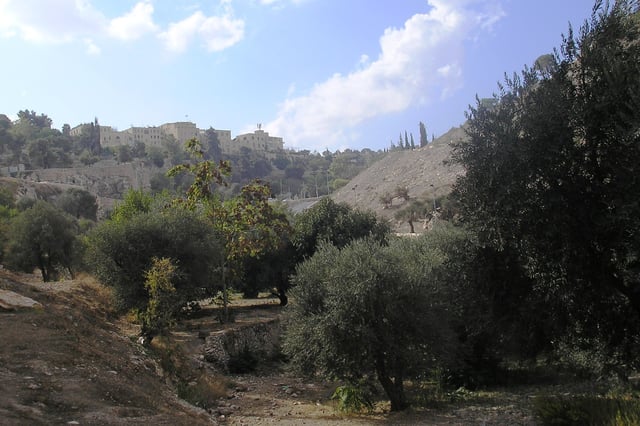
"Gehenna", Valley of Hinnom, 2007
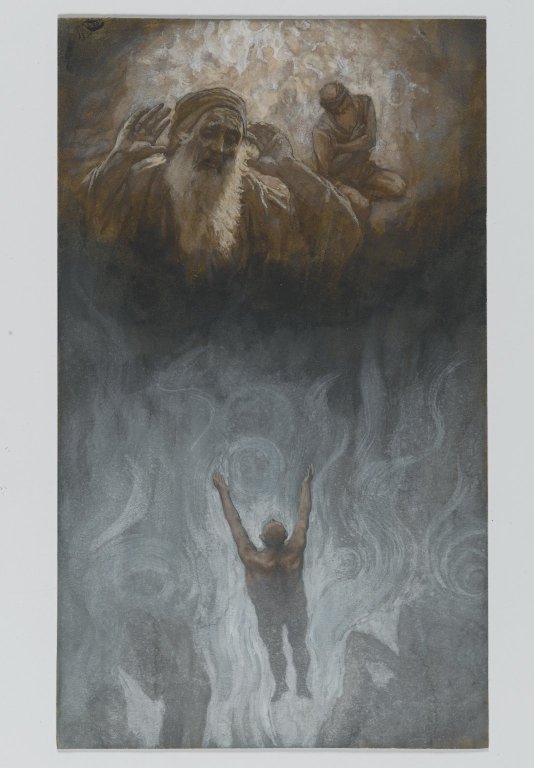
The parable of the Rich man and Lazarus depicting the rich man in hell asking for help to Abraham and Lazarus in heaven by James Tissot

Harrowing of hell. Christ leads Adam by the hand, c.1504
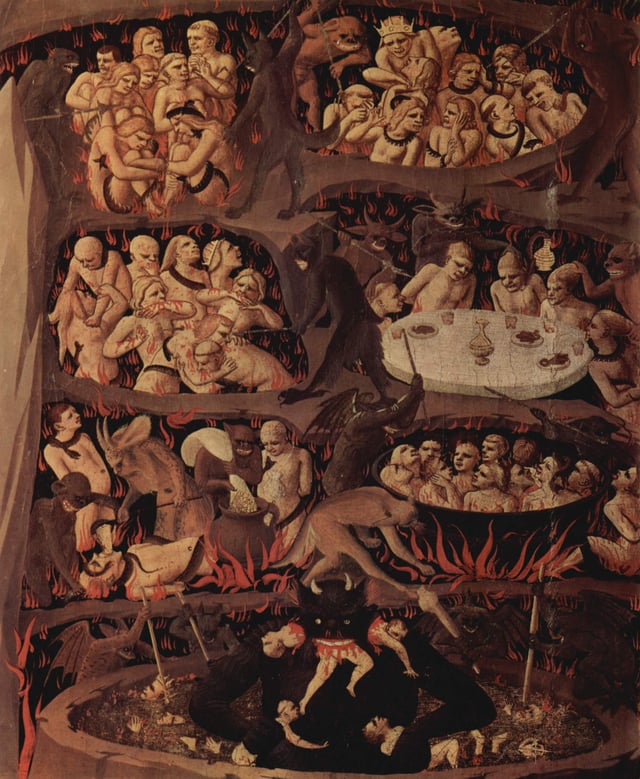
The Last Judgement, Hell, circa 1431, by Fra Angelico
The Christian doctrine of hell derives from passages in the New Testament. The word hell does not appear in the Greek New Testament; instead one of three words is used: the Greek words Tartarus or Hades, or the Hebrew word Gehinnom.
In the Septuagint and New Testament the authors used the Greek term Hades for the Hebrew Sheol, but often with Jewish rather than Greek concepts in mind. In the Jewish concept of Sheol, such as expressed in Ecclesiastes,[40] Sheol or Hades is a place where there is no activity. However, since Augustine, some Christians have believed that the souls of those who die either rest peacefully, in the case of Christians, or are afflicted, in the case of the damned, after death until the resurrection.[41]
| Hebrew OT | Septuagint | Greek NT | times in NT | Vulgate | KJV | NIV |
|---|---|---|---|---|---|---|
| שְׁאוֹל (Sheol) [42] | Ἅιδης (Haïdēs)[43] | ᾌδης (Ádēs)[[44]](http://www.perseus.tufts.edu/hopper/text?doc=Perseus:text:1999.04.0057:entry=*(/aidhs) | x10[45] | infernus[46] | Hell | Hades |
| גֵיא בֶן־הִנֹּם (Ge Hinom)[47] | Εννομ (Ennom)[48] | γέεννα (géenna)[49] | x11[50] | infernus | Hell | Hell |
| (Not applicable) | (Not applicable) | Ταρταρόω (Tartaróō)[51] | x1 | infernus | Hell | Hell |
While these three terms are translated in the KJV as "hell" these three terms have three very different meanings.
Hades has similarities to the Old Testament term, Sheol as "the place of the dead" or "grave". Thus, it is used in reference to both the righteous and the wicked, since both wind up there eventually.[52]
Gehenna refers to the "Valley of Hinnom", which was a garbage dump outside of Jerusalem. It was a place where people burned their garbage and thus there was always a fire burning there. Bodies of those deemed to have died in sin without hope of salvation (such as people who committed suicide) were thrown there to be destroyed.[53] Gehenna is used in the New Testament as a metaphor for the final place of punishment for the wicked after the resurrection.[54]
Tartaróō (the verb "throw to Tartarus", used of the fall of the Titans in Illiad 14.296) occurs only once in the New Testament in II Peter 2:4, where it is parallel to the use of the noun form in 1 Enoch as the place of incarceration of the fallen angels. It mentions nothing about human souls being sent there in the afterlife.
The Roman Catholic Church defines Hell as "a state of definitive self-exclusion from communion with God and the blessed." One finds oneself in Hell as the result of dying in mortal sin without repenting and accepting God's merciful love, becoming eternally separated from him by one's own free choice[55] immediately after death.[56] In the Roman Catholic Church, many other Christian churches, such as the Baptists and Episcopalians, and some Greek Orthodox churches,[57] Hell is taught as the final destiny of those who have not been found worthy after the general resurrection and last judgment,[58][59][60] where they will be eternally punished for sin and permanently separated from God. The nature of this judgment is inconsistent with many Protestant churches teaching the saving comes from accepting Jesus Christ as their savior, while the Greek Orthodox and Catholic Churches teach that the judgment hinges on both faith and works. However, many Liberal Christians throughout Liberal Protestant and Anglican churches believe in universal reconciliation (see below), even though it contradicts the traditional doctrines that are usually held by the evangelicals within their denominations.[61]
Some modern Christian theologians subscribe to the doctrines of conditional immortality. Conditional immortality is the belief that the soul dies with the body and does not live again until the resurrection. As with other Jewish writings of the Second Temple period, the New Testament text distinguishes two words, both translated "Hell" in older English Bibles: Hades, "the grave", and Gehenna where God "can destroy both body and soul".[62] A minority of Christians read this to mean that neither Hades nor Gehenna are eternal but refer to the ultimate destruction of the wicked in the Lake of Fire in a consuming fire after resurrection. However, because of the Greek words used in translating from the Hebrew text has become confused with Greek myths and ideas. In the Hebrew text when people died they went to Sheol, the grave[63] and the wicked ultimately went to Gehenna which is the consuming by fire. The meanings "the grave" or "death" or "eventual destruction of the wicked", were translated using Greek words, and later texts became a mix of mistranslation, pagan influence, and Greek myth associated with the word, but its original meaning was simple death or the destruction of the wicked at the end.[64]
Christian mortalism is the doctrine that all men and women, including Christians, must die, and do not continue and are not conscious after death. Therefore, annihilationism includes the doctrine that "the wicked" are also destroyed rather than tormented forever in traditional "Hell" or the lake of fire. Christian mortalism and annihilationism are directly related to the doctrine of conditional immortality, the idea that a human soul is not immortal unless it is given eternal life at the second coming of Christ and resurrection of the dead.
Biblical scholars looking at the issue through the Hebrew text have denied the teaching of innate immortality.[65][66] Rejection of the immortality of the soul, and advocacy of Christian mortalism, was a feature of Protestantism since the early days of the Reformation with Martin Luther himself rejecting the traditional idea, though his mortalism did not carry into orthodox Lutheranism. One of the most notable English opponents of the immortality of the soul was Thomas Hobbes who describes the idea as a Greek "contagion" in Christian doctrine.[67] Modern proponents of conditional immortality include some in the Anglican church such as N.T. Wright[68] and as denominations the Seventh-day Adventists, Bible Students, Jehovah's Witnesses, Christadelphians, Living Church of God, The Church of God International, and some other Protestant Christians, as well as recent Roman Catholic teaching. It is not Roman Catholic dogma that anyone is in Hell,[69] though many individual Catholics do not share this view. The 1993 Catechism of the Catholic Church states:[70] "This state of definitive self-exclusion from communion with God and the blessed is called 'hell'" and [71] "... they suffer the punishments of hell, "eternal fire." The chief punishment of hell is eternal separation from God" (CCC 1035). During an Audience in 1999, Pope John Paul II commented: "images of hell that Sacred Scripture presents to us must be correctly interpreted. They show the complete frustration and emptiness of life without God. Rather than a place, hell indicates the state of those who freely and definitively separate themselves from God, the source of all life and joy." [72]
Other denominations
The Seventh-day Adventist Church's official beliefs support annihilationism.[73][74] They deny the Catholic purgatory and teach that the dead lie in the grave until they are raised for a last judgment, both the righteous and wicked await the resurrection at the Second Coming. Seventh-day Adventists believe that death is a state of unconscious sleep until the resurrection. They base this belief on biblical texts such as Ecclesiastes 9:5 [129] which states "the dead know nothing", and 1 Thessalonians 4:13-18 [130] which contains a description of the dead being raised from the grave at the second coming. These verses, it is argued, indicate that death is only a period or form of slumber.
Adventists teach that the resurrection of the righteous will take place shortly after the second coming of Jesus, as described in Revelation 20:4-6 that follows Revelation 19:11-16, whereas the resurrection of the wicked will occur after the millennium, as described in Revelation 20:5 and 20:12-13 that follow Revelation 20:4 and 6-7, though Revelation 20:12-13 and 15 actually describe a mixture of saved and condemned people being raised from the dead and judged. Adventists reject the traditional doctrine of hell as a state of everlasting conscious torment, believing instead that the wicked will be permanently destroyed after the millennium by the lake of fire, which is called 'the second death' in Revelation 20:14.
Those Adventist doctrines about death and hell reflect an underlying belief in: (a) conditional immortality (or conditionalism), as opposed to the immortality of the soul; and (b) the monistic nature of human beings, in which the soul is not separable from the body, as opposed to bipartite or tripartite conceptions, in which the soul is separable.
Jehovah's Witnesses hold that the soul ceases to exist when the person dies[75] and therefore that Hell (Sheol or Hades) is a state of non-existence.[75] In their theology, Gehenna differs from Sheol or Hades in that it holds no hope of a resurrection.[75] Tartarus is held to be the metaphorical state of debasement of the fallen angels between the time of their moral fall (Genesis chapter 6) until their post-millennial destruction along with Satan (Revelation chapter 20).[76]
Members of The Church of Jesus Christ of Latter-day Saints (LDS Church) teach that hell is a state between death and resurrection, in which those spirits who did not repent while on earth must suffer for their own sins (Doctrine and Covenants 19:15–17[83]).
Islam
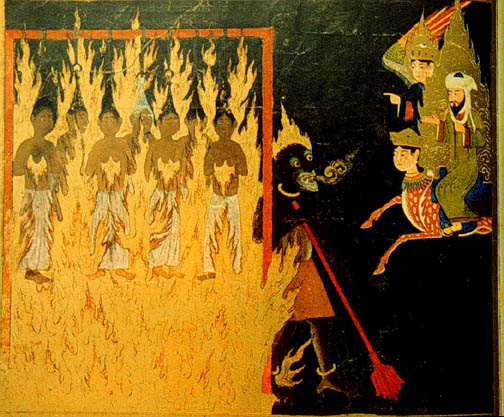
Muhammad, along with Buraq and Gabriel, visit Hell, and they see "shameless women" being eternally punished for exposing their hair to the sight of strangers. Persian, 15th century.
In Islam, jahannam (in Arabic: جهنم) (related to the Hebrew word gehinnom) is the counterpart to heaven and likewise divided into seven layers, both co-existing with the temporal world,[84] filled with blazing fire, boiling water, and a variety of other torments for those who have been condemned to it in the hereafter. In the Quran, God declares that the fire of Jahannam is prepared for both mankind and jinn.[85][86] After the Day of Judgement, it is to be occupied by those who do not believe in God, those who have disobeyed his laws, or rejected his messengers.[87] "Enemies of Islam" are sent to Hell immediately upon their deaths.[88] Muslim modernists downplay the vivid descriptions of hell common during Classical period, on one hand reaffirming that the afterlife must not be denied, but simultaneously asserting its exact nature remains unknown. Other modern Muslims continue the line of Sufism as an interiorized hell, combining the eschatological thoughts of Ibn Arabi and Rumi with Western philosophy.[89] Although disputed by some scholars, most scholars consider jahannam to be eternal.[90][91]
Medieval sources usually identified hell with the seven layers of the earth mentioned in Surah 65:12, inhabited by devils, harsh angels, scorpions and serpents, who torment the sinners. They described thorny shrubs, seas filled with blood and fire and darkness only illuminated by the flames of hell.[92] However, some sources also mention a place of extreme cold at the bottom of hell, called Zamhareer, characterized in as being unbearably cold, with blizzards, ice, and snow.[93] Maalik is thought of as the keeper of the gates of hell, namely appears in Ibn Abbas' Isra and Mi'raj.[94] Over hell, a narrow bridge called As-Sirāt is spanned. On Judgement Day one must pass over it to reach paradise, but those destined for hell will find too narrow and fall from into their new abode.[95] Iblis, the temporary ruler of hell,[96] is thought of residing in the bottom of hell, from where he commands his hosts of infernal demons.[97][98] But contrary to Christian traditions, Iblis and his infernal hosts do not wage war against God,[99] his enmity applies against humanity only. Further, his dominion in hell is also his punishment. According to the Muwatta Hadith, the Bukhari Hadith, the Tirmidhi Hadith, and the Kabir Hadith, Muhammad claimed that the fire of Jahannam is not red, but pitch-black, and is 70 times hotter than ordinary fire, and is much more painful than ordinary fire.
Polytheism (shirk) is regarded as a particularly grievous sin; therefore entering Paradise is forbidden to a polytheist (musyrik) because his place is Hell;[100] and the lowest pit of Hell (Hawiyah), is intended for hypocrites who claimed aloud to believe in God and his messenger but in their hearts did not.[101] Not all Muslims and scholars agree whether hell is an eternal destination or whether some or all of the condemned will eventually be forgiven and allowed to enter paradise.[88][99][102][103]
Bahá'í Faith
In the Bahá'í Faith, the conventional descriptions of Hell and Heaven are considered to be symbolic representations of spiritual conditions. The Bahá'í writings describe closeness to God to be Heaven, and conversely, remoteness from God as Hell.[104]
Eastern religions
Buddhism
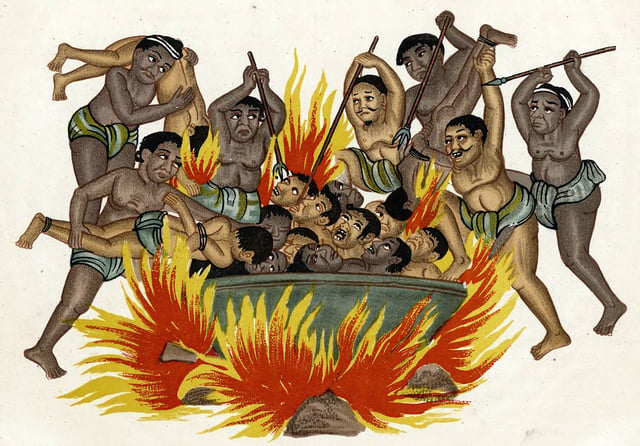
Naraka in the Burmese representation
In "Devaduta Sutta", the 130th discourse of the Majjhima Nikaya, Buddha teaches about hell in vivid detail. Buddhism teaches that there are fiveTemplate:Facr (sometimes six) realms of rebirth, which can then be further subdivided into degrees of agony or pleasure. Of these realms, the hell realms, or Naraka, is the lowest realm of rebirth. Of the hell realms, the worst is Avīci or "endless suffering". The Buddha's disciple, Devadatta, who tried to kill the Buddha on three occasions, as well as create a schism in the monastic order, is said to have been reborn in the Avici Hell.
Like all realms of rebirthi n Buddhism, rebirth in the Hell realms is not permanent, though suffering can persist for eons before being reborn again. In the Lotus Sutra, the Buddha teaches that eventually even Devadatta will become a Pratyekabuddha himself, emphasizing the temporary nature of the Hell realms. Thus, Buddhism teaches to escape the endless migration of rebirths (both positive and negative) through the attainment of Nirvana.
The Bodhisattva Ksitigarbha, according to the Ksitigarbha Sutra, made a great vow as a young girl to not reach Nirvana until all beings were liberated from the Hell Realms or other unwholesome rebirths. In popular literature, Ksitigarbha travels to the Hell realms to teach and relieve beings of their suffering.
Hinduism
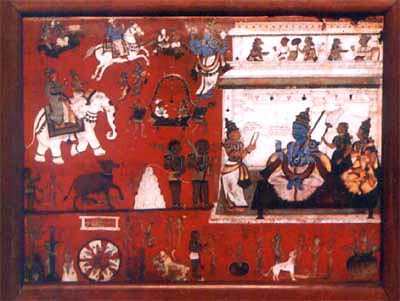
Yama's Court and Hell. The Blue figure is Yamaraja (The Hindu god of death) with his consort Yami and Chitragupta 17th-century painting from Government Museum, Chennai.
Early Vedic religion does not have a concept of Hell. Ṛg-veda mentions three realms, bhūr (the earth), svar (the sky) and bhuvas or antarikṣa (the middle area, i.e. air or atmosphere). In later Hindu literature, especially the law books and Puranas, more realms are mentioned, including a realm similar to Hell, called naraka (in Devanāgarī: नरक). Yama as the first born human (together with his twin sister Yamī), by virtue of precedence, becomes ruler of men and a judge on their departure. Originally he resides in Heaven, but later, especially medieval, traditions mention his court in naraka.
In the law-books (smṛtis and dharma-sūtras, like the Manu-smṛti), naraka is a place of punishment for sins. It is a lower spiritual plane (called naraka-loka) where the spirit is judged and the partial fruits of karma affect the next life. In Mahabharata there is a mention of the Pandavas and the Kauravas both going to Heaven. At first Yudhisthir goes to heaven where he sees Duryodhana enjoying heaven; Indra tells him that Duryodhana is in heaven as he did his Kshatriya duties. Then he shows Yudhisthir hell where it appears his brothers are. Later it is revealed that this was a test for Yudhisthir and that his brothers and the Kauravas are all in heaven and live happily in the divine abode of gods. Hells are also described in various Puranas and other scriptures. The Garuda Purana gives a detailed account of Hell and its features; it lists the amount of punishment for most crimes, much like a modern-day penal code.
It is believed that people who commit sins go to Hell and have to go through punishments in accordance with the sins they committed. The god Yamarāja, who is also the god of death, presides over Hell. Detailed accounts of all the sins committed by an individual are kept by Chitragupta, who is the record keeper in Yama's court. Chitragupta reads out the sins committed and Yama orders appropriate punishments to be given to individuals. These punishments include dipping in boiling oil, burning in fire, torture using various weapons, etc. in various Hells. Individuals who finish their quota of the punishments are reborn in accordance with their balance of karma. All created beings are imperfect and thus have at least one sin to their record; but if one has generally led a pious life, one ascends to svarga, a temporary realm of enjoyment similar to Paradise, after a brief period of expiation in Hell and before the next reincarnation, according to the law of karma.
According to Brahma Kumaris iron world (kalyug, a stage of the world cycle) is regarded as hell.
Jainism
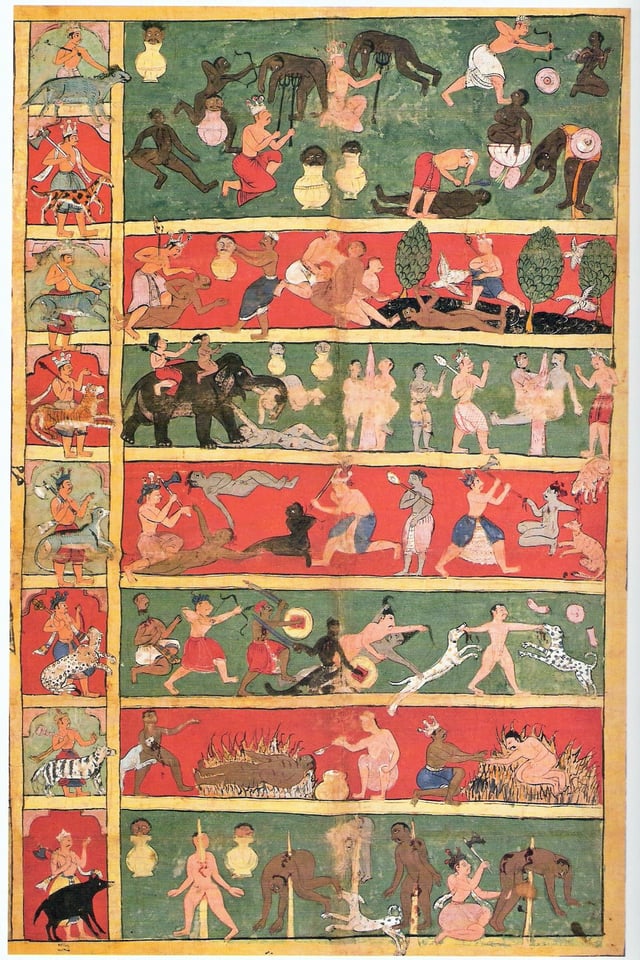
17th-century cloth painting depicting seven levels of Jain Hell and various tortures suffered in them. Left panel depicts the demi-god and his animal vehicle presiding over each Hell.
In Jain cosmology, Naraka (translated as Hell) is the name given to realm of existence having great suffering. However, a Naraka differs from the hells of Abrahamic religions as souls are not sent to Naraka as the result of a divine judgment and punishment. Furthermore, length of a being's stay in a Naraka is not eternal, though it is usually very long and measured in billions of years. A soul is born into a Naraka as a direct result of his or her previous karma (actions of body, speech and mind), and resides there for a finite length of time until his karma has achieved its full result. After his karma is used up, he may be reborn in one of the higher worlds as the result of an earlier karma that had not yet ripened.
The Hells are situated in the seven grounds at the lower part of the universe. The seven grounds are:
Ratna prabha
Sharkara prabha.
Valuka prabha.
Panka prabha.
Dhuma prabha.
Tamaha prabha.
Mahatamaha prabha.
The hellish beings are a type of souls which are residing in these various hells. They are born in hells by sudden manifestation.[105] The hellish beings possess vaikriya body (protean body which can transform itself and take various forms). They have a fixed life span (ranging from ten thousand to billions of years) in the respective hells where they reside. According to Jain scripture, Tattvarthasutra, following are the causes for birth in hell:[106]
Killing or causing pain with intense passion.
Excessive attachment to things and worldly pleasure with constantly indulging in cruel and violent acts.
Vowless and unrestrained life.[107]
Sikhism
In Sikh thought, Hell and Heaven are not places for living hereafter, they are part of spiritual topography of man and do not exist otherwise. They refer to good and evil stages of life respectively and can be lived now and here during our earthly existence.[108] For example, Guru Arjan explains that people who are entangled in emotional attachment and doubt are living in hell on this Earth i.e. their life is hellish.
So many are being drowned in emotional attachment and doubt; they dwell in the most horrible hell.
— Guru Arjan, Guru Granth Sahib 297, [109]
Taoism
Ancient Taoism had no concept of Hell, as morality was seen to be a man-made distinction and there was no concept of an immaterial soul. In its home country China, where Taoism adopted tenets of other religions, popular belief endows Taoist Hell with many deities and spirits who punish sin in a variety of horrible ways.
Chinese folk beliefs
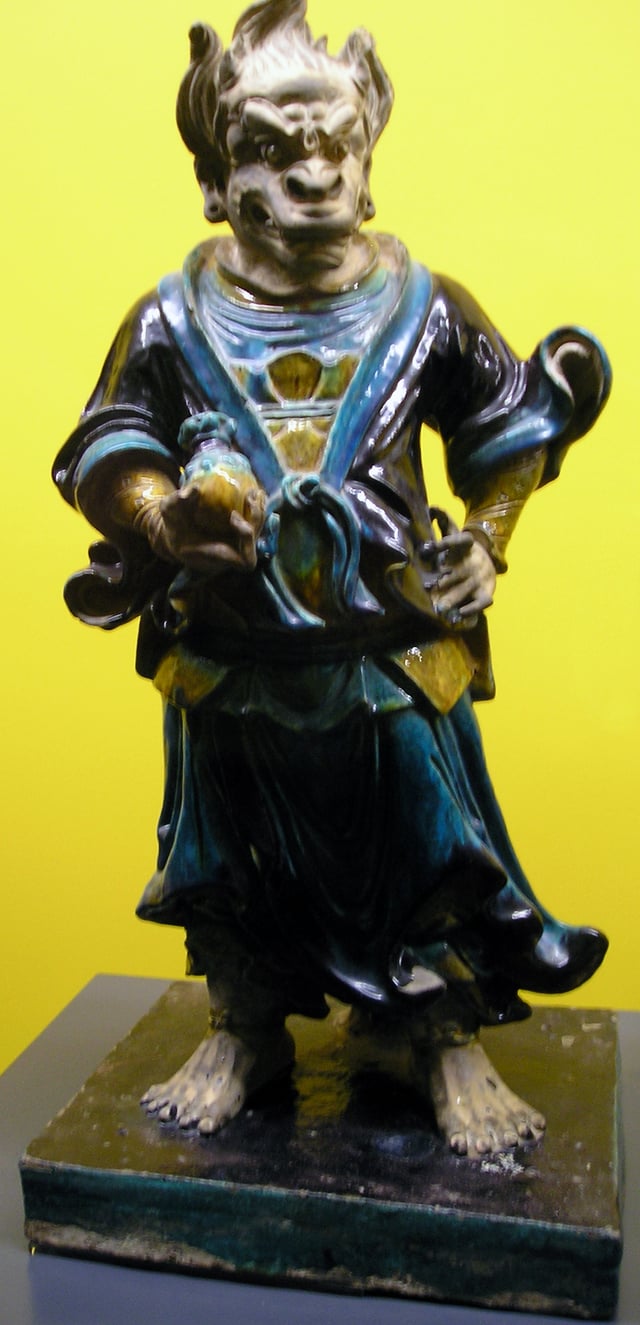
A Chinese glazed earthenware sculpture of "Hell's torturer", 16th century, Ming Dynasty
Diyu is the realm of the dead in Chinese mythology. It is very loosely based upon the Buddhist concept of Naraka combined with traditional Chinese afterlife beliefs and a variety of popular expansions and re-interpretations of these two traditions. Ruled by Yanluo Wang, the King of Hell, Diyu is a maze of underground levels and chambers where souls are taken to atone for their earthly sins.
Incorporating ideas from Taoism and Buddhism as well as traditional Chinese folk religion, Diyu is a kind of purgatory place which serves not only to punish but also to renew spirits ready for their next incarnation. There are many deities associated with the place, whose names and purposes are the subject of much conflicting information.
The exact number of levels in Chinese Hell - and their associated deities - differs according to the Buddhist or Taoist perception. Some speak of three to four 'Courts', other as many as ten. The ten judges are also known as the 10 Kings of Yama. Each Court deals with a different aspect of atonement. For example, murder is punished in one Court, adultery in another. According to some Chinese legends, there are eighteen levels in Hell. Punishment also varies according to belief, but most legends speak of highly imaginative chambers where wrong-doers are sawn in half, beheaded, thrown into pits of filth or forced to climb trees adorned with sharp blades.
However, most legends agree that once a soul (usually referred to as a 'ghost') has atoned for their deeds and repented, he or she is given the Drink of Forgetfulness by Meng Po and sent back into the world to be reborn, possibly as an animal or a poor or sick person, for further punishment.
Other religions
Zoroastrianism
Zoroastrianism has historically suggested several possible fates for the wicked, including annihilation, purgation in molten metal, and eternal punishment, all of which have standing in Zoroaster's writings. Zoroastrian eschatology includes the belief that wicked souls will remain in hell until, following the arrival of three saviors at thousand-year intervals, Ahura Mazda reconciles the world, destroying evil and resurrecting tormented souls to perfection.[110]
The sacred Gathas mention a "House of the Lie″ for those "that are of an evil dominion, of evil deeds, evil words, evil Self, and evil thought, Liars."[111] However, the best-known Zoroastrian text to describe hell in detail is the Book of Arda Viraf.[112] It depicts particular punishments for particular sins—for instance, being trampled by cattle as punishment for neglecting the needs of work animals.[113] Other descriptions can be found in the Book of Scriptures (Hadhokht Nask), Religious Judgments (Dadestan-i Denig) and the Book of the Judgments of the Spirit of Wisdom (Mainyo-I-Khard).[114]
Wicca
The two oldest sects of Wicca- Gardnerian Wicca and Alexandrian Wicca, include "the wiccan laws" that Gerald Gardner wrote. Those laws state that wiccan souls are privileged with reincarnation, but that the souls of wiccans who break the wiccan laws are sent by the goddess to the fiery christian hell.[115][116] Later wiccan sects do not necessarily include Gerald Gardner's wiccan laws. The influential wiccan author Raymond Buckland wrote that the wiccan laws are unimportant. Solitary neo-wiccans, who originated in the 1980s, do not include the wiccan laws in their doctrine.
In popular culture
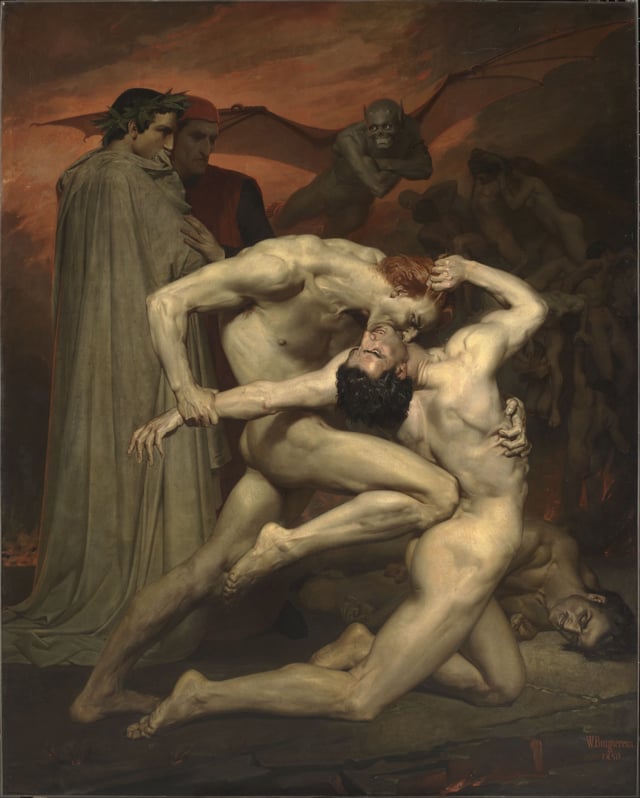
Dante and Virgil in Hell (1850) by William-Adolphe Bouguereau. In this painting, the two are shown watching the condemned.

Visit to hell by Mexican artist Mauricio García Vega.
In his Divina commedia (Divine Comedy), set in the year 1300), Dante Alighieri employed the concept of taking Virgil as his guide through Inferno (and then, in the second canticle, up the mountain of Purgatorio). Virgil himself is not condemned to Hell proper in Dante's poem but is rather, as a virtuous pagan, confined to Limbo just at the edge of Hell. The geography of Hell is very elaborately laid out in this work, with nine concentric rings leading deeper into Earth, and deeper into the various punishments of Hell, until, at the center of the world, Dante finds Satan himself trapped in the frozen lake of Cocytus. A small tunnel leads past Satan and out to the other side of the world, at the base of the Mount of Purgatory.
John Milton's Paradise Lost (1667) opens with the fallen angels, including their leader Satan, waking up in Hell after having been defeated in the war in heaven and the action returns there at several points throughout the poem. Milton portrays Hell as the abode of the demons, and the passive prison from which they plot their revenge upon Heaven through the corruption of the human race. 19th-century French poet Arthur Rimbaud alluded to the concept as well in the title and themes of one of his major works, A Season In Hell. Rimbaud's poetry portrays his own suffering in a poetic form as well as other themes.
Many of the great epics of European literature include episodes that occur in Hell. In the Roman poet Virgil's Latin epic, the Aeneid, Aeneas descends into Dis (the underworld) to visit his father's spirit. The underworld is only vaguely described, with one unexplored path leading to the punishments of Tartarus, while the other leads through Erebus and the Elysian Fields.
The idea of Hell was highly influential to writers such as Jean-Paul Sartre who authored the 1944 play No Exit about the idea that "Hell is other people". Although not a religious man, Sartre was fascinated by his interpretation of a Hellish state of suffering. C.S. Lewis's The Great Divorce (1945) borrows its title from William Blake's Marriage of Heaven and Hell (1793) and its inspiration from the Divine Comedy as the narrator is likewise guided through Hell and Heaven. Hell is portrayed here as an endless, desolate twilight city upon which night is imperceptibly sinking. The night is actually the Apocalypse, and it heralds the arrival of the demons after their judgment. Before the night comes, anyone can escape Hell if they leave behind their former selves and accept Heaven's offer, and a journey to Heaven reveals that Hell is infinitely small; it is nothing more or less than what happens to a soul that turns away from God and into itself.
Piers Anthony in his series Incarnations of Immortality portrays examples of Heaven and Hell via Death, Fate, Underworld, Nature, War, Time, Good-God, and Evil-Devil. Robert A. Heinlein offers a yin-yang version of Hell where there is still some good within; most evident in his book Job: A Comedy of Justice. Lois McMaster Bujold uses her five Gods 'Father, Mother, Son, Daughter and Bastard' in The Curse of Chalion with an example of Hell as formless chaos. Michael Moorcock is one of many who offer Chaos-Evil-(Hell) and Uniformity-Good-(Heaven) as equally unacceptable extremes which must be held in balance; in particular in the Elric and Eternal Champion series. Fredric Brown wrote a number of fantasy short stories about Satan's activities in Hell. Cartoonist Jimmy Hatlo created a series of cartoons about life in Hell called The Hatlo Inferno, which ran from 1953 to 1958.[117]
See also
Appeal to fear
Damnation
Divine retribution
Harrowing of Hell
Problem of Hell
The Well to Hell hoax
